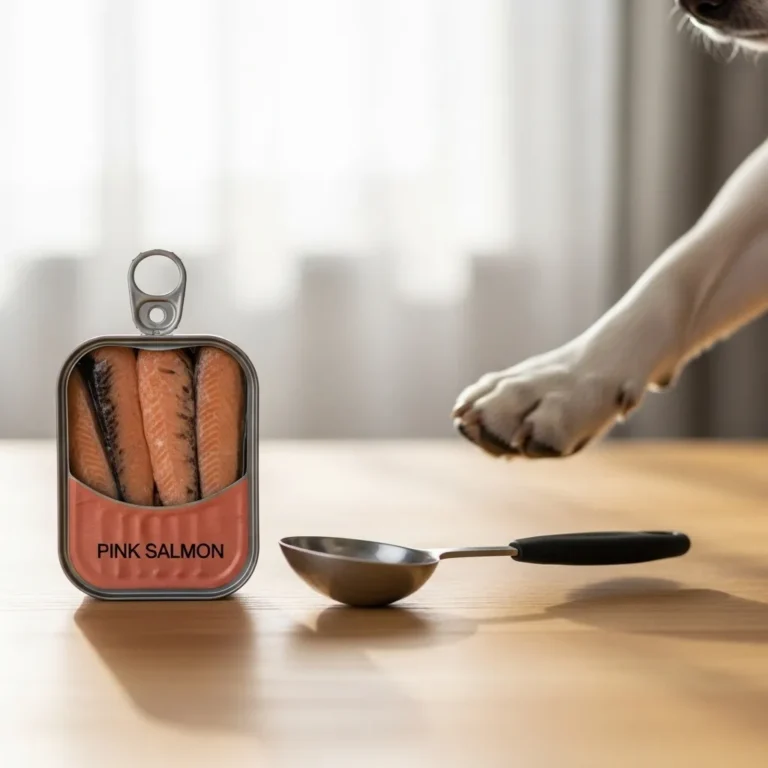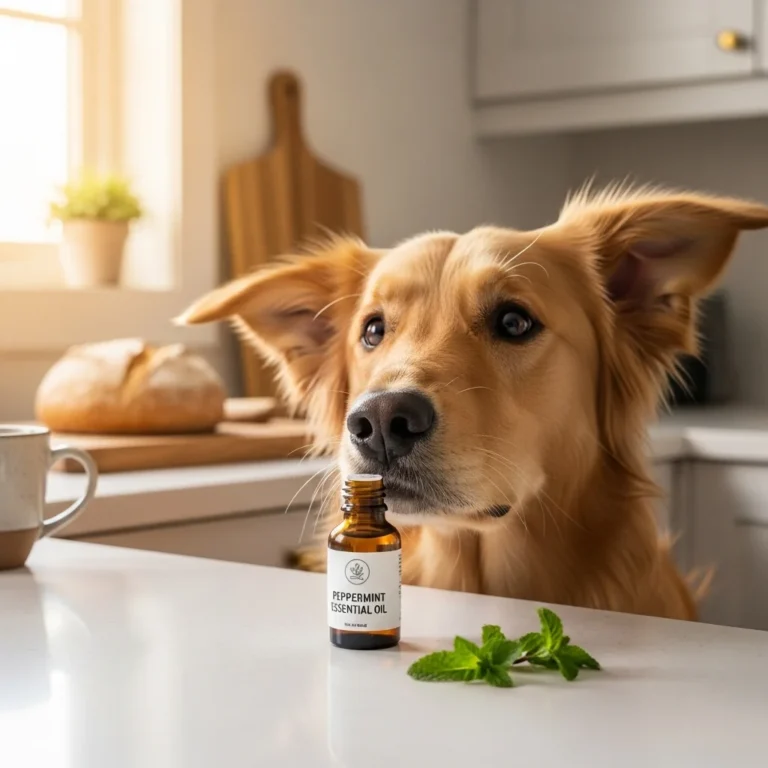
Author: DogsBlogSS Team
⚠️ Disclaimer: This article is for informational purposes only and is not a substitute for consulting a veterinarian.
can dogs have salmon
Imagine sitting at the dinner table, salmon sizzling gently in a pan, its rich aroma filling the kitchen. As you plate your portion, your loyal dog gives you that hopeful, soulful look — could a little piece of that salmon be good (or bad) for him? If you’ve ever wondered, can dogs have salmon?, you’re not alone. Salmon is a powerhouse fish, packed with nutrients, but like with any “people food,” there’s nuance. In this article, we’ll walk through everything you need to know — from its benefits and risks to how to safely prepare salmon for your canine companion.
1. General Safety & Benefits
Can dogs eat salmon safely?
Is salmon good for dogs?
According to PetMD, Yes — salmon can be a very healthy addition to a dog’s diet, when handled and prepared properly. According to PetMD, cooked, plain salmon is generally safe and provides significant nutritional benefits.
According to PetMD, Many premium commercial dog foods even use salmon as a primary protein source.
Is salmon toxic?
According to PetMD, Salmon itself is not inherently toxic to dogs. The risk typically comes from improper preparation (like serving it raw) or from additives (seasonings, too much salt, etc.).
According to PetMD , When cooked plain, salmon is one of the safer fish options — it tends to have low levels of mercury compared to some larger predatory fish.
According to PetMD, That said, always get the go-ahead from your vet when introducing any new food into your dog’s diet, especially if they have existing health issues.
Can puppies eat salmon?
When it comes to puppies, the same caution applies — but with some extra care. Puppies are still growing, so their diet must be balanced very carefully. While salmon can offer tremendous benefits (more on that below), it should be introduced gradually and in small amounts, under your veterinarian’s guidance. Given their developing digestive systems, too much new protein or fat too soon may cause tummy upset.
What are the health benefits of salmon for dogs?
Salmon isn’t just tasty for our furry friends — it’s packed with good stuff:
- According to Hepper Pet Resources, Omega-3 fatty acids: Salmon is rich in EPA and DHA, two omega-3s that support healthy skin and coat, reduce inflammation, and even aid joint health.
- According to PetMD, High-quality protein: It helps dogs build and repair muscle, and it’s a lean, digestible protein.
- According to Hepper Pet Resources, Vitamins and minerals: Salmon offers B vitamins (like B12), selenium, vitamin D, and other nutrients that support brain function, immunity, and overall cellular health.
- According to Vetnaturals Blog, Joint and mobility support: Thanks to omega-3s, salmon (or salmon oil) may help with joint inflammation, especially in older or arthritic dogs.
- According to joyfulhounds, Heart and cognitive benefits: The anti-inflammatory properties of omega-3s support cardiovascular health, and DHA can help cognitive function, especially in puppies or older dogs.
2. Critical Risks (Raw & Smoked)
Can dogs eat raw salmon or sushi?
According to PetMD, This is where things get risky. Feeding raw or undercooked salmon to dogs can potentially lead to Salmon Poisoning Disease (SPD).
According to pubmed, The danger comes not from salmon itself being toxic, but from a parasite called Nanophyetus salmincola that carries Neorickettsia helminthoeca — a bacterium that causes SPD.
According to MSD Veterinary Manual, The MSD Veterinary Manual explains that when dogs eat raw salmon infected with this parasite, the bacteria can infect their system.
According to Veterinary Public Health, Symptoms may include vomiting, diarrhea, lethargy, fever, and swollen lymph nodes.
According to MSD Veterinary Manual, Early diagnosis and treatment with antibiotics like doxycycline or tetracycline are critical; untreated SPD can be fatal.
What is Salmon Poisoning Disease (SPD)?
Symptoms of eating raw salmon:
According to Veterinary Public Health, Dogs may show signs within a week of exposure — typically vomiting, diarrhea (sometimes bloody), fever, lethargy, and enlarged lymph nodes.
According to PMC, As the disease progresses, lab tests may reveal low platelets (thrombocytopenia) or low albumin (hypoalbuminemia).
Nanophyetus salmincola:
According to MSD Veterinary Manual, This is the trematode (fluke) that harbors Neorickettsia helminthoeca. When dogs ingest fish carrying the parasite, the fluke matures in their intestines, releasing the bacterium that causes SPD.
According to Veterinary Public Health, The life cycle involves snails in freshwater, which infect fish; those fish then carry the metacercariae, which can infect dogs.
According to MSD Veterinary Manual, For diagnosis, vets might use fecal tests to detect N. salmincola eggs, or cytology on lymph nodes to look for N. helminthoeca organisms.
According to PMC, If treated early — typically with doxycycline — dogs often recover quickly.
can dogs have smoked salmon (lox/gravlax)?
Smoked salmon (lox or gravlax) is generally not a smart choice for dogs. Even if it’s cooked, the smoking or curing process often adds a lot of sodium, which can be harmful to dogs. Plus, seasoning or flavorings used in smoked salmon (like garlic or onion) can be toxic to dogs. The high salt content alone can lead to electrolyte imbalances, dehydration, or worse.
3. Canned & Processed Salmon
can dogs have canned salmon?
According to Vetnoms , Yes — canned salmon can be a safe and convenient way to feed salmon to your dog, if done carefully. According to a veterinarian on VetNoms, canned salmon offers protein, omega-3s, and valuable micronutrients. However, you should choose plain canned salmon, ideally packed in water, with no added salt or seasoning.
Is it better to feed dogs salmon in water or oil?
According to Chander Hills, When it comes to canned salmon, water-packed is usually the safer bet. It tends to have less added fat and salt compared to versions packed in oil. That said, if you’re using salmon oil supplements (not whole canned fish), those provide concentrated omega-3s and can be very beneficial — just be cautious of the dose and quality. Experts point out that poor-quality oils can go rancid or be mixed with other oils, so always pick a trusted brand.
Are the bones in canned salmon safe for dogs?
According to vetnoms, Canned salmon often contains soft, pulverized bones, especially if it’s wild-caught. These are generally safe — the canning process softens the bones, making them easy to chew and digest.
However, you must still check for any harder bone fragments and remove large pieces to avoid choking. Avoid giving cooked or raw hard fish bones (like many uncooked salmon bones) — these can splinter and injure your dog’s throat or digestive tract.
4. Parts of the Fish (Skin, Bones, Heads)
can dogs have salmon skin?
According to PetMD, Yes — they can, under the right conditions. According to PetMD, cooked, plain salmon skin (with the scales removed or fully cooked) is safe for dogs and even quite nutritious.
According to Darwin’s , In fact, the skin may contain even more omega-3s than other parts of the fish. But because skin is fatty, it’s best given in small amounts to avoid digestive upset.
Can dogs eat salmon bones?
According to dial a vet, This depends a lot on the type of bone:
- Raw or cooked hard bones (like big chunks from a salmon steak): Not advisable. These can splinter and pose a choking risk, or damage the digestive tract.
- Soft bones (like in canned salmon): Usually okay when they’re fully cooked and very soft. Still, supervise your dog while eating, and make sure there are no large or sharp bits.
Can dogs eat salmon heads?
According to dial a vet, Some people might wonder whether offering a salmon head is a natural or raw-food treat. While the head does have nutritional value (fat, some calcium, and other nutrients), it’s risky. There could be small bones, cartilage, and potentially hard or sharp edges. Unless it’s very well prepared (cooked completely, bones softened, deboned to some degree), it’s safer to avoid giving salmon heads to your dog.
5. Preparation & Seasoning
How should I cook salmon for my dog?
To keep salmon safe and healthy for your dog, cook it simply:
- Bake: Place the salmon on a plain baking sheet, bake at a moderate temperature (e.g., 350°F / 175°C) until fully cooked, no pink in the center.
- Steam: Use a steamer basket or a pot with a little water, steam gently until cooked through.
- Poach: Simmer in water (or low-sodium broth) until the salmon flakes easily with a fork.
Avoid any seasonings, spices, herbs, or heavy fats. Your goal is plain, fully cooked salmon, free from added ingredients that might harm your dog.
Can dogs eat seasoned salmon?
Generally, no, seasoned salmon is risky. Here’s why:
- Lemon: A small squeeze of lemon may not be toxic, but large amounts can upset a dog’s stomach.
- Garlic & Onion: These are on the “do not feed” list — they can damage a dog’s red blood cells (anemia risk).
- Butter & Oil: Too much fat can lead to pancreatitis or upset tummy.
- Other spices: Many seasonings are high in sodium or contain other harmful ingredients.
Stick to unseasoned, cooked salmon if you’re sharing with your dog.
Can dogs eat freeze-dried salmon or jerky?
Yes — but choose wisely. Freeze-dried salmon treats or jerky made specifically for dogs can be a great option, because they’re typically fully cooked (or treated in a way that eliminates parasites) and designed for canine consumption. Just pick high-quality, reputable brands that disclose sourcing and processing methods. Avoid any “human jerky” with added salt, spices, or potentially toxic ingredients.
6. Quantity & Frequency
How much salmon can I feed my dog?
According to PetMD, Here are some general guidelines (derived from PetMD’s advice) for how much cooked, boneless salmon is safe for a dog, based on weight:
| Dog Size | Suggested Weekly Portion |
|---|---|
| Extra-small (2–20 lb) | 1–2 ounces |
| Small (21–30 lb) | 2–3 ounces |
| Medium (31–50 lb) | 3–4 ounces |
| Large (51–90 lb) | 4–6 ounces |
| Extra-large (90+ lb) | 6–8 ounces |
These are just ballpark figures. Always check with your vet — especially if your dog is on a prescription diet, has special health needs, or is very active or very sedentary.
Can I feed my dog salmon every day?
Feeding salmon every day is generally not recommended, unless you’re using a carefully balanced plan. There are a few reasons for this:
- According to The Natural Dog Store, Mercury & contaminants: Like all fish, salmon can contain trace heavy metals (though salmon is relatively low in mercury compared to big predatory fish).
- Fat/calories: Too much salmon can add a lot of fat, which may contribute to weight gain or digestive issues.
- Nutritional balance: A balanced diet means variety. Relying too heavily on salmon could crowd out other necessary nutrients.
A safer pattern is to use salmon as a supplement or treat, not the main daily protein source, unless you’re under veterinary guidance.
Conclusion
So, can dogs have salmon? Absolutely — but like so many good things, it’s all about how you give it. When cooked plainly, salmon can be a nutritious, boost-of-omega-3 treat that supports your pup’s skin, coat, joints, and overall health. But raw salmon is risky (because of Salmon Poisoning Disease), and smoked or heavily seasoned salmon can be harmful.
If you’re thinking of adding salmon to your dog’s diet — whether as occasional cooked bites, canned salmon, or high-quality salmon oil — chat with your veterinarian first. They’ll help you figure out the right serving size, how to prepare it safely, and whether it fits your dog’s overall dietary needs.
Notice : The DogsBlogSS editorial team is dedicated to providing accurate, research-based information about dog health, behavior, and care. All our articles are fact-checked using trusted veterinary sources such as VCA Hospitals, Merck Vet Manual, and the AKC.
you may like it






